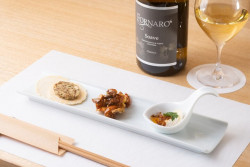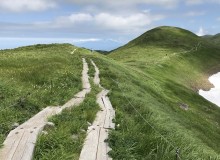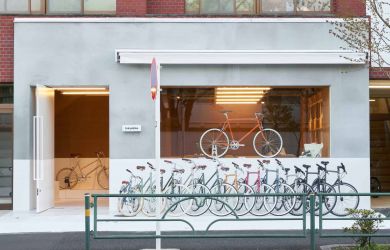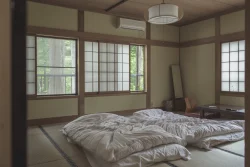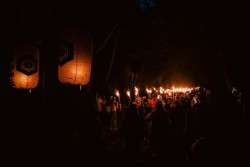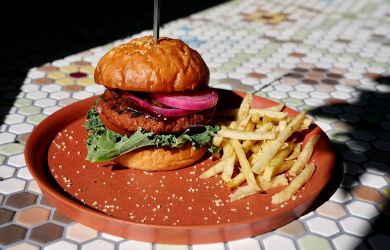
December 9, 2010
(Central) Eastern Promises
It’s the Tokyo neighborhood tipped for greatness. So why does it feel like Nagoya?
By Metropolis
Originally published on metropolis.co.jp on December 2010

“It’s like a place that everybody forgot,” says Yoshiyuki Shimizu. “You’re so close to Tokyo station, you’ve got Nihombashi—which is known all over Japan—just down the road, and yet there are all these empty buildings here.”
We’re having lunch at One Drop Cafe in Iwamotocho, slap in the middle of what Shimizu (below) likes to call Central East Tokyo. If you believe the breathless reports in some quarters of the Japanese media, this is fast on its way to becoming one of the coolest neighborhoods in the capital, and Shimizu has been its most enthusiastic cheerleader. His website, CET Trip, provides information on upcoming events in the area, along with an invaluable map of the key spots. Invaluable, because there’s virtually no chance you’d find them otherwise.
 The borders of Central East Tokyo are vague, though for argument’s sake you could say it’s delineated by Yasukuni Dori in the north and Ningyocho in the south, with Showa Dori on one side and the Sumida River on the other. It’s accessed via stations that you probably wouldn’t think to get off at otherwise: Bakurocho, Higashi-Nihombashi, Kodenmacho. Historically, this is the Tonyagai, the city’s fashion wholesale district, and it retains the comforting odor of old-school Tokyo, with all its resonances and obscure demarcations.
The borders of Central East Tokyo are vague, though for argument’s sake you could say it’s delineated by Yasukuni Dori in the north and Ningyocho in the south, with Showa Dori on one side and the Sumida River on the other. It’s accessed via stations that you probably wouldn’t think to get off at otherwise: Bakurocho, Higashi-Nihombashi, Kodenmacho. Historically, this is the Tonyagai, the city’s fashion wholesale district, and it retains the comforting odor of old-school Tokyo, with all its resonances and obscure demarcations.
“They still talk about ‘those folks across the river’ sometimes,” says Takashi Doi, proprietor of the bar, gallery and event space Om Chan Tone. His shop sits just off the road that disembarking travelers would take on their way from the dock to the pleasure quarters of Yoshiwara, in present-day Ningyocho. Not too far away is the site of the jail where 18th-century scholar and scientific dabbler Hiraga Gennai was held after one of his notorious drunken escapades.
Yet this neighborhood of entrenched lore, family businesses and deeply unfashionable clothing emporia is also home to a growing population of artists, architects, designers and bicycle freaks. You know—the hip crowd.
They’ve taken advantage of the many vacant properties in the district, transforming workshops and rundown office buildings into ateliers, galleries, cafes and design studios, or spaces that blur these categories together. “A lot of the buildings around here weren’t originally up for rent,” explains Shimizu. “Even if they were empty, it wasn’t a problem for the owners… so we just ask people if it’s OK to use them.”
 To anyone accustomed to the scrap-and-rebuild approach that passes for urban development in much of Tokyo, this is pretty refreshing. At the Agata Takezawa building, a former office block, you can lunch on falafel while checking out the latest exhibit in Art+Eat Bakurocho, head across the corridor to the Foil Gallery or upstairs to browse through shops selling Czech children’s storybooks and Deutschland ephemera. Yet there’s also an old-fashioned dry cleaning company there, and underwear (whose, I’m not sure) hanging to dry on the rooftop.
To anyone accustomed to the scrap-and-rebuild approach that passes for urban development in much of Tokyo, this is pretty refreshing. At the Agata Takezawa building, a former office block, you can lunch on falafel while checking out the latest exhibit in Art+Eat Bakurocho, head across the corridor to the Foil Gallery or upstairs to browse through shops selling Czech children’s storybooks and Deutschland ephemera. Yet there’s also an old-fashioned dry cleaning company there, and underwear (whose, I’m not sure) hanging to dry on the rooftop.
Across the street, the five-decade-old Colorworks Palette building was recently transformed into an unlikely blend of Italian restaurant, deli and paint showroom. Head southwest for five minutes and you’ll get to the former Kuroda building, another complex dating back 50 or 60 years that reopened in the summer, freshly renovated and with the new name Dig Dug. It’s now home to a couple of bars, while a pizzeria occupies the lofty first-floor space that once housed a local pharmacy.
“It had a unique feel to it,” says Yoshihisa Otsubo, the owner of Il Tamburello, who makes a mean margherita. “I was in Italy for two or three years, and I wanted to capture that kind of atmosphere… The ceiling’s high, and I thought it’d make an interesting space, with a real European flavor.” The fact that the building isn’t even hooked up to the gas mains is a bonus, as far as he’s concerned: “Yeah, they all use propane in Naples.”
 At the end of October, Central East Tokyo hosted a sprawling yet weirdly low-key art festival, where yet more vacant blocks were turned into temporary exhibition and event spaces. One of these, the Murakami building, is now being renovated by a group of artists, and is due to reopen later in the month as a complex of art studios and design offices.
At the end of October, Central East Tokyo hosted a sprawling yet weirdly low-key art festival, where yet more vacant blocks were turned into temporary exhibition and event spaces. One of these, the Murakami building, is now being renovated by a group of artists, and is due to reopen later in the month as a complex of art studios and design offices.
“They’re broke, so they’re doing the renovation themselves,” says Shimizu. “It’s not going to be perfect, but that’s part of the appeal.”
At some point in the future, historians might look back at the last decade and mark the point where Tokyo stopped being able to keep up with the media’s demand for Next Big Things. They might also be able to say with some certainty whether or not Central East Tokyo was one of them.
It’s certainly been getting enough attention recently. Free magazine Metro Mins devoted an entire issue to the neighborhood in October, while heavyweight culture mag Brutus featured the area in its August survey of eastern Tokyo’s creative renaissance, gushing: “It’s gone from being somewhere just for people in the know, to a place that anyone can enjoy.”
Which is true, in as far as it goes. Yet visitors looking for the capital’s answer to Shoreditch or Williamsburg may well trundle home wondering what the fuss was about. Wandering around on a Saturday afternoon, when the streets are practically devoid of traffic, the new Soho reminded me more of a slow day in Nagoya.
“There’s been a lot of media buzz, but I think people who come here expecting to find lots of things to do will be disappointed,” Shimizu says. “It’s not like Takeshita Dori in Harajuku, where there are rows and rows of shops… It’s more like a treasure hunt: everything’s hidden.”
 “If you walk around, it’s just a lot of buildings—you’ve no idea where anything is,” agrees Toshiyuki Komatsu, the former consultant who now runs One Drop Cafe. When his customers complain that there’s nothing interesting to see in the area, he offers to take them to one of the galleries nearby, where they can then get pointers from the staff on where to go next. “When you do that, they often come back for more,” he says.
“If you walk around, it’s just a lot of buildings—you’ve no idea where anything is,” agrees Toshiyuki Komatsu, the former consultant who now runs One Drop Cafe. When his customers complain that there’s nothing interesting to see in the area, he offers to take them to one of the galleries nearby, where they can then get pointers from the staff on where to go next. “When you do that, they often come back for more,” he says.
One Drop (right) opened in July last year, in a renovated car repair shop, and its premises are sufficiently spacious to host music gigs along with rakugo performances and more esoteric events, such as when a sake-dispensing kimono troupe took it over for one night last month. Thanks in part to a dearth of similar venues, it’s become one of the key hangouts in Central East Tokyo, and offers a window into the state of the neighborhood milieu.
“I don’t know if I should hold up Aoyama as an example,” says Komatsu, “but with places like that, if your job and way of thinking are different from other people’s then you don’t mix with them. When you come here, it’s natural to mingle, just because you’re neighbors. People come together, regardless of what their field is. I think that’s pretty interesting.”
“Well, it’s partly because there just aren’t many people here,” Shimizu chips in. “If you organized a designers’ get-together in Aoyama, you might get 50 people turning up. Here, it would be more like three.”
 So what is the appeal of this neighborhood, what pizza maestro Otsubo describes an “air pocket” between other, apparently more important, places? “It doesn’t have a distinctive color,” says Shimizu. “Areas like Koenji and Shimokitazawa have a certain image—you can say, ‘Oh, I’m in such-and-such a mood today, so I’ll go to Koenji, or to Harajuku, or Shibuya.’ But this area doesn’t have that. You don’t have a clear idea of what’s going to happen here.”
So what is the appeal of this neighborhood, what pizza maestro Otsubo describes an “air pocket” between other, apparently more important, places? “It doesn’t have a distinctive color,” says Shimizu. “Areas like Koenji and Shimokitazawa have a certain image—you can say, ‘Oh, I’m in such-and-such a mood today, so I’ll go to Koenji, or to Harajuku, or Shibuya.’ But this area doesn’t have that. You don’t have a clear idea of what’s going to happen here.”
Maybe that isn’t enough to satisfy some people, but he doesn’t seem particularly bothered. “Honestly, we’re just getting started.”
For information about upcoming events and a map of local attractions, see http://cet-trip.com (Japanese).
Address Book
Agata Takezawa Bldg
1-2-11 Higashi-Kanda, Chiyoda-ku. Most shops and galleries closed Sun & hols. Nearest stn: Bakurocho.
Colorworks Palette Bldg
1-14-2 Higashi-Kanda, Chiyoda-ku. Tel: 03-3864-0810. Open Mon-Sat 10am-6pm, closed Sun. Nearest stn: Bakurocho. www.palette-bldg.com
Om Chan Tone
4-11 Nihombashi-Tomizawacho, Chuo-ku. Tel: 03-6206-2626. Open Mon-Sat 11:30am-late, closed Sun & hols. Nearest stn: Ningyocho.
One Drop Cafe
2-9-11 Iwamotocho, Chiyoda-ku. Tel: 03-5829-6822. Open Mon-Sat 11:30am-2am, closed Sun & hols. Nearest stn: Kodenmacho or Iwamotocho. www.onedrop-cafe.com
Pizzeria Il Tamburello
1-2-9 Nihombashi-Horidomecho, Chuo-ku. Tel: 03-6661-6628. Open Mon-Sat 11:30am-2pm and 5-11pm, closed Sun. Nearest stn: Kodenmacho.
